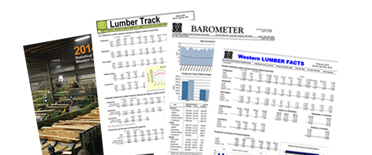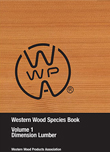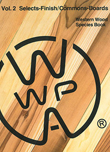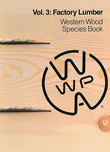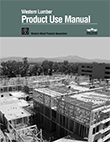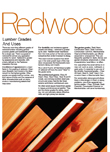
Other Species
Western Cedars
Western Red, Incense, Port Orford and Alaskan Yellow cedars are grouped together for similar performance properties. The heartwood of these species is naturally durable against the harsh effects of exposure to the elements. They are favorites for decks, siding, planters, fences, and other outdoor amenities such as screened porches, greenhouses, pool-side structures, arbors, and trellises. The sapwood of these species also pressure treats well with preservatives for added durability.
Grades for cedar products can be very confusing to the uninitiated because every purveyor seems to offer their own grades. However, there are recognized standard and special grades for cedar products. It is important for designers and specifiers to learn the difference between ALSC-recognized grades (defined by ALSC-accredited agencies), the proprietary grades defined through buyer-seller agreements, and marketing names used primarily for promotional purposes.
Western Red Cedar is the largest and most abundant of all cedars in managed forests. It is non-resinous and has a strong spicy scent. Heartwood varies from dark reddish brown to a pinkish color and has excellent weather-resistant properties. Sapwood is light yellow. One of the lightest in weight of the commercially important softwoods, it is often used for houseboats. It is valued for paneling, decks, and greenhouses as well as for siding, posts, fencing, shingles and shakes.
Incense Cedar has a famously spicy scent and is widely available. Heartwood is light brown, frequently tinged with red and is extremely durable. A highly workable wood, it machines and weathers well. Used outdoors for amenities and landscaping applications, it is also used for paneling, chests, louvers and pencils.
Port Orford Cedar is limited in supply and availability. It grows only in a small area of southern Oregon and northern California, and very limited amounts are harvested from private lands and made available, usually only by request. It is priced accordingly. It has a pungent, ginger-like scent, is easily worked, and polishes well. In Japan, it is sometimes substituted for Hinoki when appearance is critical. It is used for small items such as wooden-ware, novelties and toys.
Alaskan (Yellow) Cedar is one of the most beautiful of America's durable softwoods and is sometimes overlooked in favor of more publicized species. However, it is reasonably abundant from Alaska and Canada. It has a fine texture and straight grain, and its nearly yellow color silvers exquisitely upon exposure. Strongly aromatic, it is moderately strong and hard. It is used where weather resistance, stability and work-ability are needed: bleachers, park benches, exterior cabinet work, stage construction, and marine and commercial landscape installations.
Western Spruces and Lodgepole Pine
The alternate (Western only) species combination of Engelmann Spruce and Lodgepole Pine (ES-LP) is well suited for truss design and other engineered applications. Additional information on ES-LP for truss design is detailed in WWPA's Tech Note No. 3 available from the Association's Technical Services Dept.
Engelmann and Sitka Spruces are nearly white in color with a distinctive, slightly pinkish-grey tone. Relatively small, uniformly distributed knots add to the appeal of the medium to fine texture and straight grain.
Lodgepole Pine has relatively straight grain, white to yellow sapwood with light, reddish-brown heartwood. Knots do not bleed through paint. It is used for interior paneling, joinery, structural timber and poles. When creating interiors or rustic designs with Western pines, remember that while Lodgepole resembles other Western pines in appearance, it is the strongest of the Western pines. This makes LP additionally useful for selected structural elements when a "pine aesthetic" is desirable.
Spruce-Pine-Fir (South)
This species combination, classed as moderately strong, is cross-continental in origin. Because of similar design values, the combination includes Engelmann and Sitka spruces, and Lodgepole Pine from the West, along with Balsam Fir, Jack Pine, Red Pine and several eastern spruces from the U.S. Northeast. SPF-S grademarked products may originate from either region and be graded either by or according to grading rules published by WWPA, the West Coast Lumber Inspection Bureau (WCLIB), or the Northeastern Lumber Manufacturers' Association (NELMA).
SPF-S design values make it appropriate for general framing applications. In the higher, structural light framing grades, dimension products are appropriate for light trusses and other engineered applications. In MSR lumber, SPF-S lumber is interchangeable with Canadian SPF lumber because Western mills conduct mandatory quality control on the specific gravity for 2.0E grade if the 2.0E grade is run in combination with a higher E grade(s).
Western Woods
In a structural performance context, the term, "Western Woods" specifically indicates a combination of the Western pines (Ponderosa, Sugar, and Idaho White Pine), Mountain Hemlock and Alpine Fir because these species share similar design values. While these species are not the strongest among Western species, they can carry heavy loads when large members are used. Their real appeal and strengths are in the appearance grades: COMMONS, ALTERNATE BOARDS, SELECTS and FINISH, and in the Factory and Shop products.
The term "Western Woods", when not used in connection to assigned design values and structural performance, may also describe any non-specific combination of any or all Western species except Western cedars.
Douglas Fir-South (DF-S)
Products originating from trees grown in Arizona, Colorado, Nevada, New Mexico and Utah are designated Douglas Fir-South. Douglas Fir-South is set apart from DF or DF-L by its slightly lower design values for structural applications. DF-S is always marketed separately for design and engineering, but interchangeable with DF and DF-L in appearance grades.
Other Western Pines
Sugar Pine is the tallest of the Western pines, bearing enormous cones that can be well over a foot long. It is moderately strong with a fairly uniform texture. Sapwood is creamy white, heartwood darkens to a light brown and is occasionally red tinged. It has a faint odor, good dimensional stability, and is used for general joinery, foundry patterns, boxes and crates, paneling and shelving.
Idaho White Pine (also called Western White Pine) varies from nearly white to pale reddish brown and darkens with exposure. It is famous for its workability across or with the grain and is valued for joinery, foundry patterns, paneling, interior trim, furniture, boxes and siding. It is the preferred species for stage flooring in theaters. Availability is limited.


